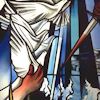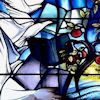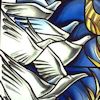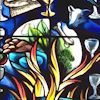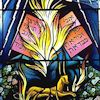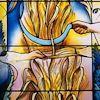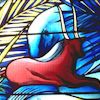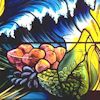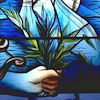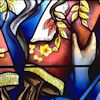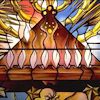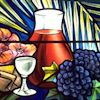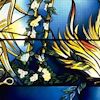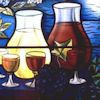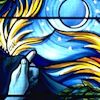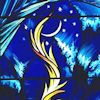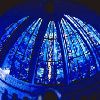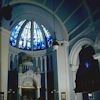WWW.GLASSPAINTER.COM
-ARCHITECTURAL GLASS ARTIST
The Queens Park Synagogue Project
This was an amazing project that I was commissioned to make in the early 1990's. The windows, apart from the Dome, half dome, are on the theme of the Jewish Festivals.This was the most incredible project to make. The first set, Rosh Hoshanah and Yom Kippur, Pesach and Shavuos were all made in my Glasgow Studio. The rest of the windows beginning with the Sabbath through Sukkot, Simchat Torah, Chanukah, Rosh Chodesh and the rest of the minor fesitals were made at the Derix Studio in Germany.
Recently, I made a small film showing the windows and the dismantling and removal of these windows from Queens Park Synagogue. This was filmed for the television quality of the time.
I was in Glasgow in 2017 and filmed the windows in their new location. I hope to create a film about the windows in the new location. There is also a historical documentary that could be made about the project.
This is a video I made in 2017 as I was sent some video cassettes that Wolfgang Groh and I had filmed in Glasgow in the early 200s, just before the synagogue closed down.
The windows were moved to Giffnock Synagogue where they are to this day. All except for the half dome. It remains crated, if not forgotten, but it is unsure if this work will ever see the light of day again.
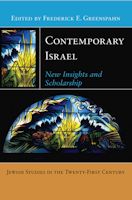
It has been a great pleasure to have my windows for Queens Park Synagogue used for the cover of this series of books for the New York University Press.
It is interesting to see the images take on a life of their own.
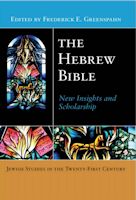
It has been a great pleasure to have my windows for Queens Park Synagogue used for the cover of this series of books for the New York University Press.
It is interesting to see the images take on a life of their own.
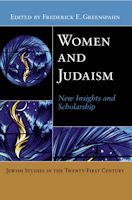
It has been a great pleasure to have my windows for Queens Park Synagogue used for the cover of this series of books for the New York University Press.
It is interesting to see the images take on a life of their own.
go to book
Major Festivals
Pesach
The Spring Season
This is simply a spring window showing a hazy and still cool sun. The
time of year when nature comes to life again after a long dark winter.
The atmosphere is the coolness and freshness of early spring. The new
growth on the earth and in the waters combine to give nourishment and sustenance.
On the first day of Pesach prayers for dew are said.
 A part of the "Song of Solomon"
A part of the "Song of Solomon"
“For Lo the winter is past, the rain is over and gone,
The flowers appear on the earth, the time of singing has come,
The voice of the turtle is heard in our land,
the fig tree puteth forth her green figs,
And the vines in blossom give forth their fragrance.”
In the three agricultural festivals; Pesach, Shavuos and Sukkot, the seven types of
agricultural produce; wheat, barley, grapes, figs, pomegranates, olives and dates,
are shown during three stages.
In this window they are blossoming and at the new growth phase. Included also are the
citron and the willow which are necessary for the festival of Sukkot.
The focal point of this window is a tree containing several different species. This tree
is also found in the Shavuos window at the fruit bearing stage but here the tree is in
blossom.
It has branches containing several different species, ie the fig, olive and pomegranate,
also included are the citron and the willow which relate to the Festival of Sukkot. At the base of this window is a palm which is a symbol of triumph and righteousness.
"The righteous will flourish like a palm tree",(PS 92:12).
The Season of Freedom
An alternative version of the above passage from the Song of Solomon reads;
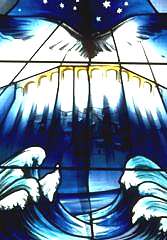 "for the winter of bondage has passed
"for the winter of bondage has passed
the deluge of suffering is over and gone.
The righteous blossoms are seen in the land,
the time of your song has arrived
and the song of your guide is heard in the land.
The fig tree has formed its first small figs,
ready for ascent to the Temple.
The vines are in blossom,
their fragrance declaring they are ready for libation."
This is only now symbolically linked with nature, the emphasis is now on
national redemption.
This window depicts the flight from Egypt. The two main symbols are the parting of the Sea
at the base and the eagle at the top. This symbol can be read as both the eagle referred to
in the passage from Exodus 19:4,
"..and how I bore you on eagles' wings, and brought you unto Myself."
however it should also be seen as symbolic of the "Angel of Death" which passed
over the homes of the Israelites during the final and most
devastating plague on the Egyptian captors. The killing of the first-born. This Passing
Over is regarded as the meaning of Pesach.
It is also known as the Season of our Freedom as it marks the liberation of Israel from
Egypt and its birth as a free nation. It is also one of the most frequently recurring symbols
in Judaism and is often alluded to in writings and prayers. Therefore throughout the series
of windows it is a constantly recurring theme.
"...He brought us forth from bondage to freedom,
From sorrow to joy, from mourning to festivity
from darkness to bright light and from servitude to redemption...."
The chains in the border represent the chains of bondage.
There are twelve stars and twelve gateways, the gateways to heaven, representing the twelve
tribes of Israel.
Festival of Matzot - Seder
This panel represents the Seder Meal. This is the main meal of the festival,
held on the evening of Passover. Its origin is extremely ancient and possibly
goes back to the time of Abraham. And certainly to the time of the Exodus.
The symbolism begins at the base of the window with the ritual burning of any
leaven which is in the house.
In Exodus 12 it is written
15. Seven days shall ye eat unleavened bread; howbeit the first day ye shall put
away leaven out of your houses; for whosover eateth leavened bread from the first
day until the seventh day, that soul shall be cut off from Israel.
The house is searched rigorously for any leaven or anything containing leaven.
There is a token of the heating of cooking implements in the fire, (Koshering) until
they become red hot. Above that is boiling water in which other implements are being
heated, (another method of Koshering)
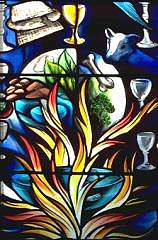
Above this is the main Seder dish containing:
Matzot - unleavened bread, commemorates the hasty exodus from Egypt.
Seder Dish comprises.
The shankbone - A Roasted bone placed on RHS, represents the Paschal Lamb.
The egg - Hard-boiled egg, slightly roasted placed on LHS represents the second lamb which was sometimes needed on Passover when there was not enough for the assembled group. It did not carry the same restrictions as the Paschal lamb.
The bitter herbs - Horseradish symbolizing the bitterness of bondage, this is placed in the centre of the dish. Lettuce can also be used as at first it tasted sweet then becomes bitter.
Charoset - compound of apples nuts cinnamon and wine. symbolizing the mortar used by the slaves in their labour.
Karpass (vegetable) - usually parsley which is dipped into salt water.
Salt water - represents the tears shed by the Israelites.
Three Matzot, known as the bread of affliction. The centre one is broken and a piece hidden. Known as the Afikomen.
4 Cups of wine - Drunk in token of the 4 expressions of redemption.
and I shall bring out
and I shall deliver
and I shall repent
and I shall tame.
During Passover, wine represents as follows,
The first cup as the Kiddush
The second in hope that the next Passover may take place in the Messianic kingdom.
Third is part of the grace after meals,
Fourth looks to ultimate redemption.
The cup of Elijah - 5th cup of wine kept for Elijah.
The Leviathan (great fish or whale) and Behemoth (the great red ox)
although mostly associated with Sukkot seemed to be also appropriate
here representing the Messianic age which is hoped and prayed for at
each Passover. The fifth cup of wine, here represented by the golden
cup is designated for Elijah the Prophet. It is believed that before
the beginning of the Messianic age, Elijah will return and it is expected
that he will return during Pesach.
The scales are for one of the four times of judgement mentioned
in the introduction. This time for the Day of Judgement for grain.
This is also the time of the beginning of the counting of the Omer.
Shavuos
The Giving of the Torah
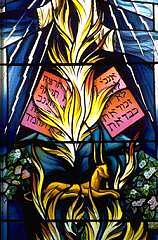
This window focuses on the event on Mount Sinai when God gave Moses
the Decalogue.
By tradition the Giving of the Torah occurred 49 days after the escape
from Egypt.
It is considered to be the fulfilment of the Exodus.
The central image is the tablets of the law. Above are horns blowing, lightning
flashing and a pillar of fire descending on the mountain.
It is also said that the mountain-side flowered.
At the base of the window is the burning bush recalling another mountain-side
at an earlier time. This is used as a symbol for the Calling of Moses and
to bring together the whole series of events culminating in the receiving
of the Torah.
Above is the golden calf surrounded by darkness.
First Fruits in Israel

As with the Spring Season the main symbols in this window
are again the seven biblical species now in their fruit stage.
The two main symbols are the palm and the tree with several species.
At the base of the window a sickle is being used to cut wheat giving a
link to the next window.
As with the Spring Season Window, the colouring here emphasises the season
of the year. Therefore it is warm and bright.
The scales represent The Time of Judgement for the fruit of the trees.
Since it is the summer festival, the people brought the first produce of
the fields to the sanctuary as thanksgiving.
"The choicest first fruits of thy land thou shalt bring into the house
of the Lord thy God."Exodus 23:19.
Wheat Harvest in Israel
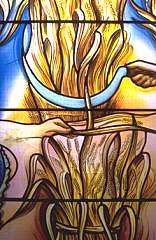
This and The First Fruits window have the colouring for a summer harvest
festival.
This window emphasises the wheat harvest which is the background to the
story of Ruth which is read during Shavuos. She is represented by a hand
gleaning behind the sickle.
15. When she got up to glean, Boaz instructed the men to glean right among
the sheaves. 'Do not find fault with her,' he added;
16. 'you may even pull out some ears of grain from the handfuls as you
cut, and leave them for her to glean;...Ruth 2:
At the top on either side is a representation of the burnt offerings which
would have been offered at the Temple in Jerusalem.
Sukkot
Booths
"Ye shall dwell in booths seven days; all that are homeborn in Israel shall dwell
in booths" Lev 23:42.
The 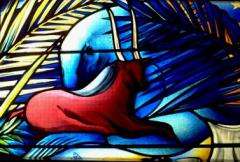 Booth known as a Tabernacle or a Sukkah is traditionally built in the garden.
The most important part of the booth is the roof (sekhakh) through which you must be able
to see the stars if the sky is clear. It is not important which trees the branches for the
roof come from.
Booth known as a Tabernacle or a Sukkah is traditionally built in the garden.
The most important part of the booth is the roof (sekhakh) through which you must be able
to see the stars if the sky is clear. It is not important which trees the branches for the
roof come from.
By tradition the booth is a symbol of the destroyed temple and a reminder of the wanderings in the wilderness.
It should be decorated festively and fruits are hung from the roof.
The males of the household are instructed to eat meals inside the booth during the
festival, females only have to enter for the benediction.
The arch of this window contains two palm branches which represent the roof of
the Sukkah. In the border area are golden vine leaves which here symbolise the Temple.
There was a great golden vine which surrounded one of the doors to the Temple. As the
leaves move upwards they become the stars which are seen through the roof of the Sukkah.
The Leviathan and Behemoth are represented in the hope of a share in the feast in the Sukkah
in the Hereafter. All who fulfil the "mitzvah of Sukkah" in this one, the Holy One blessed be
He will grant him a share in the Sukkah of Leviathan in the future to come. Refers
to the feast of the great fish and the ox in the life to come.
The Lulav and the citron, which are used in prayers during Sukkot are held
and candles are lit.
Ingathering of Crops
"..... on the fifteenth day of the seventh month, when ye have gathered in the fruits of the land, ye shall keep the feast of the Lord seven days;..." Lev 23:39.
 The arched area of this panel has the other possible interpretation of the Sukkah, Cloud by day and fire by night.
It also contains a reminder of the Exodus in the form of the parting of the sea as in window No 6.
Again the crops shown here are the seven types of produce which have been represented throughout the agricultural windows have now been harvested and put in storage.
Sukkot was widely and joyfully celebrated in the days of the Temple. It was considered the most joyful of the festivals and was sometimes called simply the Festival.
The four species were identified with the final harvest the fertility of the land and for the giving of thanks to God.
Flowers and fruit are symbols of joy.
The arched area of this panel has the other possible interpretation of the Sukkah, Cloud by day and fire by night.
It also contains a reminder of the Exodus in the form of the parting of the sea as in window No 6.
Again the crops shown here are the seven types of produce which have been represented throughout the agricultural windows have now been harvested and put in storage.
Sukkot was widely and joyfully celebrated in the days of the Temple. It was considered the most joyful of the festivals and was sometimes called simply the Festival.
The four species were identified with the final harvest the fertility of the land and for the giving of thanks to God.
Flowers and fruit are symbols of joy.
The Four Specie
s"And ye shall take you on the first day the fruit of goodly trees, branches of palm trees, and boughs of thick trees, and willows of the brook, and ye shall rejoice before the Lord your God for seven days." Lev 23:40.
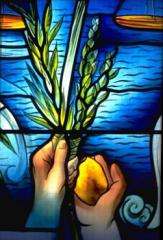
 The four species, consisting of the lulav, etrog, hadass, arava.
dominate this window by circling the arch, this refers to the waving in all directions of the four species during prayers.
The scales are again shown as a time of judgment for water.
The lulav is used on the first 7 Days of Sukkos excepting the Sabbath.
The four species were identified with the final harvest the fertility of the land and the thanksgiving.
It is used by the Reader (Chazan) in the synagogue service. It is waved in all directions indicating the whole universe.
This window is also dominated by Hoshanah Raba the 7th Day of Sukkot, the day of judgement for water. The temple ritual reached a climax on this day for prayers for water and there was a water libation ceremony over the alter in the Temple. In ancient days the water was drawn from a well at the foot of Jerusalem, the vessel used was a golden flask. approximately 3 pints. At the same time, Levites played trumpets and harps, flutes and cymbals. At each part of the water libation ritual, priests blew trumpets.
The Hoshanah is a cluster of willow twigs. In the days of the Temple these were branches with which the ground surrounding the alter was circled and beaten with the willow branches. In more recent times after a procession with the Torah around the Bimah, etrog and the lulav are laid aside and willow branches taken up, five of them bound with a leaf from the lulav. At the end of the Hoshana prayers the worshippers beat the branches on the ground and chant a ritual passage. According to ritual law it is necessary only to beat them five times but the mass of the congregation goes on beating until all the leaves have fallen off. Everyone performs this ceremony including women and children. Some carry the twigs home to act as a broom during the searching for Chometz on the next Passover.
The four species, consisting of the lulav, etrog, hadass, arava.
dominate this window by circling the arch, this refers to the waving in all directions of the four species during prayers.
The scales are again shown as a time of judgment for water.
The lulav is used on the first 7 Days of Sukkos excepting the Sabbath.
The four species were identified with the final harvest the fertility of the land and the thanksgiving.
It is used by the Reader (Chazan) in the synagogue service. It is waved in all directions indicating the whole universe.
This window is also dominated by Hoshanah Raba the 7th Day of Sukkot, the day of judgement for water. The temple ritual reached a climax on this day for prayers for water and there was a water libation ceremony over the alter in the Temple. In ancient days the water was drawn from a well at the foot of Jerusalem, the vessel used was a golden flask. approximately 3 pints. At the same time, Levites played trumpets and harps, flutes and cymbals. At each part of the water libation ritual, priests blew trumpets.
The Hoshanah is a cluster of willow twigs. In the days of the Temple these were branches with which the ground surrounding the alter was circled and beaten with the willow branches. In more recent times after a procession with the Torah around the Bimah, etrog and the lulav are laid aside and willow branches taken up, five of them bound with a leaf from the lulav. At the end of the Hoshana prayers the worshippers beat the branches on the ground and chant a ritual passage. According to ritual law it is necessary only to beat them five times but the mass of the congregation goes on beating until all the leaves have fallen off. Everyone performs this ceremony including women and children. Some carry the twigs home to act as a broom during the searching for Chometz on the next Passover.
Simchat Torah
(Rejoicing of the Law)
"Let us be glad and rejoice with this law,
For it is strength and light for us"
The day is called Shemeni Azeret the eighth day of solemn assembly. Later Shemeni Azeret
also came to be known as Simchat Torah "Rejoicing of the Torah". In the
Diaspora this name was applied to the second day of the festival sometime after the 10th Cen C.E.
In the prayer book it is still referred to as Shemeni Azeret. Although it is now
considered as
the concluding part of Sukkot it is in fact a separate festival.
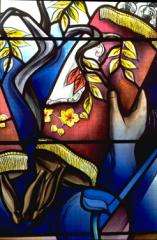 A tradition grew in this period of celebrating the ending of the annual reading of
the Torah. This was justified by reference to the Midrash which described how Solomon
had celebrated when he was granted wisdom. The people should therefore celebrate when
they have received the wisdom of the Torah. This theme is symbolised in the window.
A tradition grew in this period of celebrating the ending of the annual reading of
the Torah. This was justified by reference to the Midrash which described how Solomon
had celebrated when he was granted wisdom. The people should therefore celebrate when
they have received the wisdom of the Torah. This theme is symbolised in the window.
The centre of Jewish worship focuses on the Torah, which is housed in a specially
built and often elaborately decorated ark. The scrolls are rolled toward their centre
on two staves, this is known as the Tree of Life which is another symbolic name for
the Torah.
They are adorned with special ornaments and often kept inside velvet covers with
silver breastplates.
The Sefer Torah (scroll of the Law) from which the portions are read weekly in the
synagogue is a Jewish communities most treasured possession.
At the centre of this window is the Tree of Knowledge.
Simchat Torah marks the end of the one year cycle of the reading of the law.
As soon as the final portion of Deuteronomy is read,
a second scroll is opened and Genesis begun. At one end of the window is a
symbol of the first book of Genesis, showing the physical separation of the
light from the darkness. At the other end is a symbol for the light of wisdom
representing the completion of Deuteronomy and therefore the completion of
reading the Torah.
The symbol for seven inside the circle stands for the Hakkafot. This is a ceremonial
procession around the synagogue or elsewhere.
It has been a custom that some Hebrew letters would be written in honey and a child
would lick them off so that the first taste of the Law was sweet. "How sweet are your words to my taste, sweeter than honey to my mouth." psalm 119 103.
Boys under Barmitzvah age are also called up to the reading desk and after an adult
has recited the blessing, a portion of the law is read for them while a large Tallit
(prayer shawl) is held over them like a canopy.




